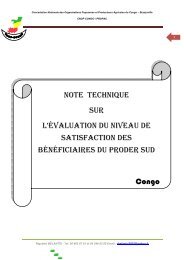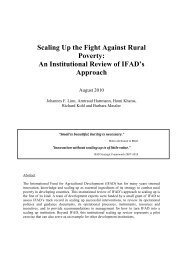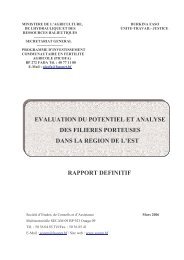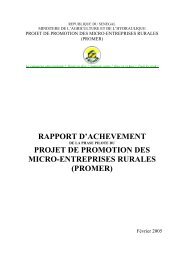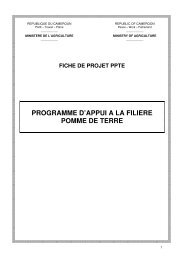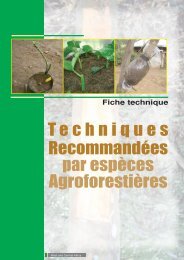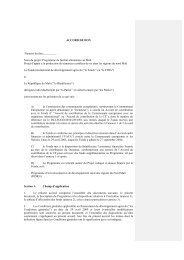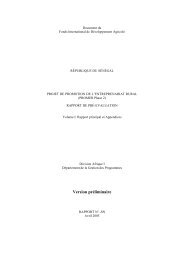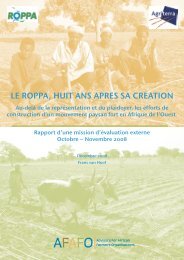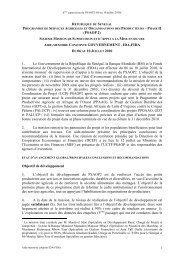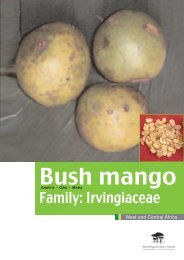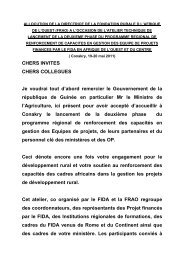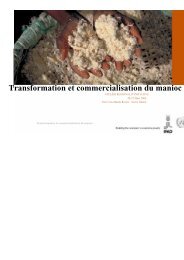CASSAVA OPPORTUNTIES IN NIGERIA - FAO.org
CASSAVA OPPORTUNTIES IN NIGERIA - FAO.org
CASSAVA OPPORTUNTIES IN NIGERIA - FAO.org
Create successful ePaper yourself
Turn your PDF publications into a flip-book with our unique Google optimized e-Paper software.
6 THE ULTIMATE WAY FORWARD<br />
The task to be faced now is to how to develop<br />
successful long-term relationships between<br />
members of the cassava supply chain (farmers to<br />
agribusiness entrepreneurs) to address and<br />
resolve the problems faced by everyone from<br />
ineffectual markets, low levels of technology use,<br />
and inadequate policy and regulatory systems.<br />
There is no shortage of recommendations. The<br />
team while undertaking this study identified no<br />
less than 300 recommendations 25 . Each one was<br />
suggested as a means for addressing a genuine<br />
problem or concern. Rather than listing them here<br />
(although it is strongly recommended that one<br />
should review them for future consideration) it was<br />
preferred to suggest a process or way forward to<br />
building a legitimate and respected cassava<br />
industry in Nigeria that may activate its own<br />
solutions.<br />
To date cassava remains, in the eyes of most<br />
Nigerians, a food security or self-sufficiency crop.<br />
Although their consumption of cassava in the form<br />
of processed gari and fufu suggests otherwise,<br />
the perception remains strong. It is not thought of<br />
as an agrifood industry capable of moving the<br />
Nigerian economy forward. It is not thought of as<br />
able to provide a marketable convenience food to<br />
a growing urban market nor as an export-earning<br />
provider. It is not known by the general population<br />
that it is capable of providing high quality flour,<br />
starch, animal feed and ethanol energy. These<br />
are just some of the knowledge gaps, attitudes<br />
and mind-sets that must change and if changed,<br />
will stimulate cassava’s role and importance in<br />
Nigeria’s agricultural economy and overall<br />
development.<br />
6.1 THE OBJECTIVE<br />
This will entail support from champions outside<br />
and inside the industry. In the early years of<br />
change this will most likely be initiated through<br />
small-scale processing chains and vertical<br />
integration in selected industries. To get there<br />
cassava partners must start to think bigger.<br />
25 The list is available upon request.<br />
35<br />
Thinking bigger in this context means partners<br />
must begin thinking beyond one’s own enterprise;<br />
thinking beyond their operations; thinking<br />
backwards by forming strong and trusted linkages<br />
with one’s suppliers of raw material and thinking<br />
forwards by forming strong and trusted linkages<br />
with one’s customers.<br />
Thinking bigger is not about thinking of bigger<br />
profit margins or bigger outputs and capacities.<br />
Thinking bigger is first thinking about ensuring that<br />
contracts are fulfilled and high levels of quality<br />
and service are maintained throughout the supply<br />
chain all the way to final consumer satisfaction.<br />
Final and intermediate consumer satisfaction will<br />
ensure the success of the cassava industry. Small<br />
firm level successes will eventually lead to bigger<br />
successes and ultimately the success of a larger<br />
industry.<br />
6.2 BENEFICIARIES<br />
The anticipated beneficiaries of a successful<br />
cassava supply chain are the producers,<br />
processors, traders, transporters and consumers<br />
of cassava today and in the future. Cassava,<br />
presently and accurately is described as an<br />
orphaned commodity without institutional,<br />
<strong>org</strong>anizational and policy support. The number of<br />
intended beneficiaries can be thought of as the<br />
sand in an hourglass: a large number of<br />
smallholder producers feeding into a narrow<br />
opening of traders, processors and final product<br />
distributors, opening again to a large number of<br />
low-income consumers of the final product.<br />
6.3 THE PROCESS<br />
The process for change must be demand driven.<br />
In this analysis untapped value added product<br />
opportunities for cassava were identified in urban<br />
convenience foods such as ready to eat or serve<br />
gari and fufu, breads and snacks to name just a<br />
few. Cassava crop expansion was identified as<br />
willing and able. The constraints that prevent<br />
production from meeting its demand potential are<br />
vast, as evident from interviews with industrialists,<br />
producer groups, state extension officers,<br />
previous reports (NAPA, etc) and the list of<br />
recommendations. Yet, given these vast<br />
constraints there remains hope and optimism that<br />
these constraints can be overcome if the industry<br />
is able to find a way to work together for its



